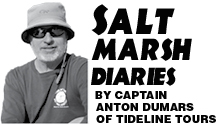Myths and Mysteries of Dynamite Hole
 First off, let’s tackle something that’s more misinformation than myth. There floats, on a mooring, a dark-hulled boat near the Folly Beach boat landing. Its traditional hull shape and sheer line attracts lots of eyes. People notice when the boat sinks after a heavy rain. And people notice when the boat recovers from the sinkings. More than one Follyite has approached me concerned about my sinking boat. I respond with “What the! When? Oh… not mine, phew!” To those who showed concern, thank you, but not my boat.
First off, let’s tackle something that’s more misinformation than myth. There floats, on a mooring, a dark-hulled boat near the Folly Beach boat landing. Its traditional hull shape and sheer line attracts lots of eyes. People notice when the boat sinks after a heavy rain. And people notice when the boat recovers from the sinkings. More than one Follyite has approached me concerned about my sinking boat. I respond with “What the! When? Oh… not mine, phew!” To those who showed concern, thank you, but not my boat.
The Real Myth: Dynamite Hole caused Folly’s erosion problem. What is Dynamite Hole? It’s an 800-1000 foot gap, approximately a quarter mile off Morris Island, designed into Charleston’s south jetty. Dynamite Hole vents a portion of Charleston Harbor’s ebb tidal flow. At full ebb flow, the water rushes through this hole in a torrent. Some suggest that this strong ebb current has swept Folly’s sand away. I’ve heard this story around town since I first arrived here in 1980. I read about this rumor in DNR’s South Carolina Wildlife Magazine. I’ve even heard it recently at Folly Beach Town Hall.
Most readers know about Folly’s jetty-induced erosion woes. For those who don’t, here’s a brief synopsis: Charleston’s north jetty blocks a significant volume of southbound longshore sediment. Coastal geologists Duncan Fitzgerald and Miles Hayes, in a 1979 peer-reviewed journal article, present strong evidence in support of this hypothesis. As a result, sediment-starved Morris and Folly Island both experience retreat.
Prior to jetty completion in 1895, Charleston’s natural channel arched southward, becoming almost shore-parallel just offshore Morris Island. Along this channel’s seaward course, an ebb tidal delta formed, catching and storing large volumes of wave-transported southbound sand. Every so often, the channel avulsed northward to a more efficient path. This process abandoned large packages of sand to the south side of the channel’s new course. Over time, this abandoned sand worked itself south onto Morris and Folly Islands, keeping both islands relatively stable.
At this pre-jetty channel’s delta terminus, a persistent sandbar chronically hindered navigation, challenging Charleston’s shipping interests. Charleston’s jetty construction, modeled after James Eads design for the Mississippi River, stabilized and realigned the channel perpendicular to the shoreline. The new channel solved the shipping issue, but created Folly and Morris Island’s erosion problem. By 1920 (25 years after jetty construction), the former (natural) channel began filling in. It’s associated ebb tidal delta collapsed. Folly and Morris Island’s natural renourishment ceased, prompting retreat of both Islands.
With the system’s background now explained, let’s get back to the myth: Does Dynamite hole cause Folly’s erosion? Here’s what happens in a natural channel. When water flows, it also carries sediment. A confined natural channel persists until it becomes unconfined, such as when flowing into the ocean or a lake. Once unconfined, the stream looses competence. In other words, the current slows down and drops its sediment load. This is how deltas form. If we examine the seaward side of the Stono River Inlet, the North Edisto River Inlet, and Lighthouse Inlet, we find a delta. If we examine the mouth of the Mississippi River, we find a delta.
As Dynamite Hole’s channel becomes unconfined beyond the south jetty, it should form a delta. Based on the above three examples, the current should not persist for four miles south with enough force to erode Folly Island.
I studied NOAA bathymetric chart 11521, CHARLESTON HARBOR AND APPROACHES. Clearly marked are Dynamite Hole’s red and green buoys. Just beyond these buoys, I find shoaling and breakers — the makings of a delta. If Dynamite Hole’s current flowed with enough force to erode Folly, we would see an associated channel. According to the chart, none exists. Instead of washing sand away from Folly, Dynamite Hole deposits sand towards Folly. Based on this evidence, I’m calling this myth busted…
Next time Folly Beach needs renourishment sand, look no further than the mouth of Dynamite Hole. Isn’t it kind of our sand anyway?
Anton DuMars, owner of Tideline Tours, is a coastal geologist and longtime Folly resident. Visit www.tidelinetours.com and sign up to receive limited off charter offers.

